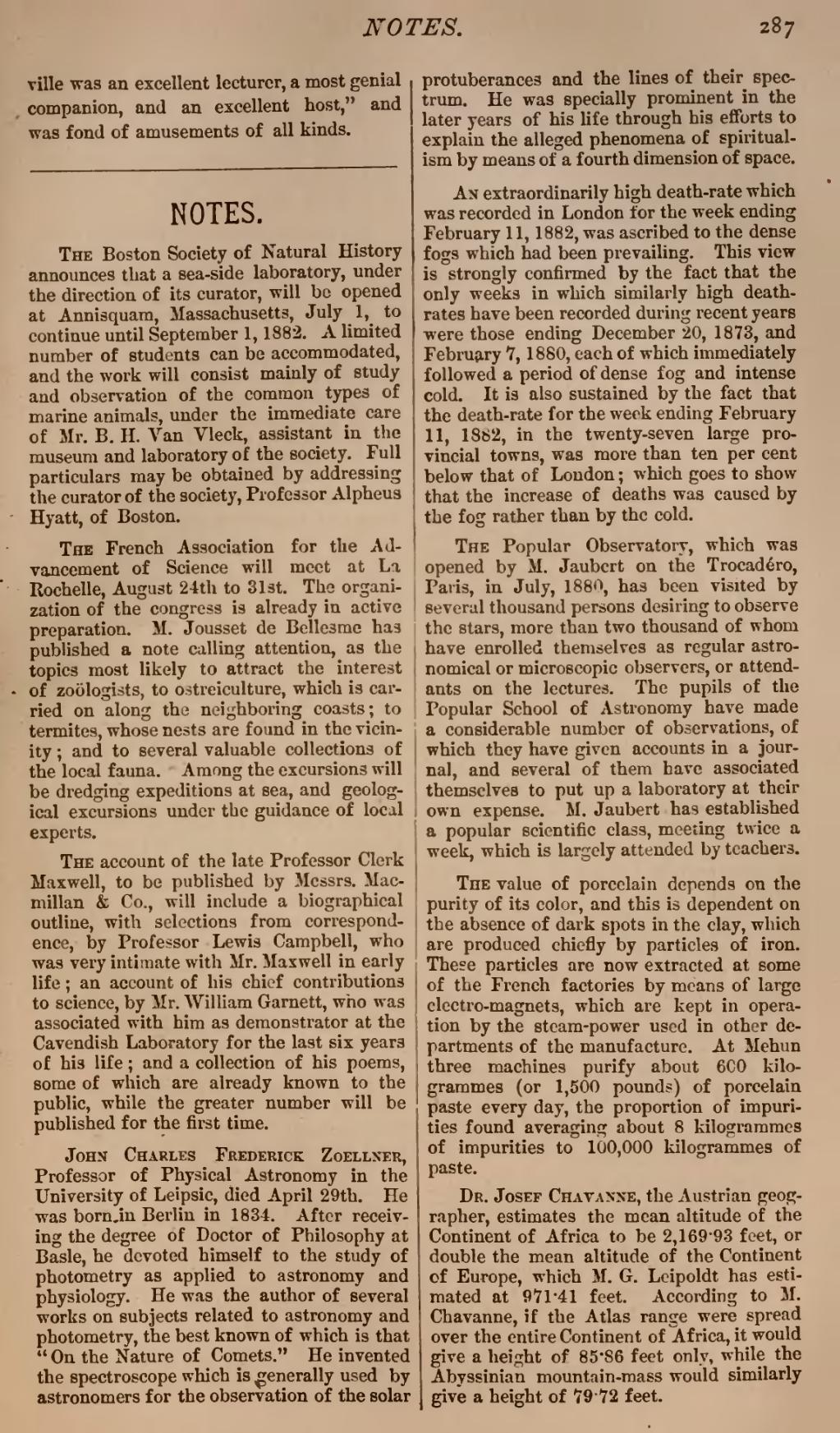ville was an excellent lecturer, a most genial companion, and an excellent host," and was fond of amusements of all kinds.
The Boston Society of Natural History announces that a sea-side laboratory, under the direction of its curator, will be opened at Annisquam, Massachusetts, July 1, to continue until September 1, 1882. A limited number of students can be accommodated, and the work will consist mainly of study and observation of the common types of marine animals, under the immediate care of Mr. B. H. Van Vleck, assistant in the museum and laboratory of the society. Full particulars may be obtained by addressing the curator of the society, Professor Alpheus Hyatt, of Boston.
The French Association for the Advancement of Science will meet at La Rochelle, August 24th to 31st. The organization of the congress is already in active preparation. M. Jousset de Bellesme has published a note calling attention, as the topics most likely to attract the interest of zoölogists, to ostreiculture, which is carried on along the neighboring coasts; to termites, whose nests are found in the vicinity; and to several valuable collections of the local fauna. Among the excursions will be dredging expeditions at sea, and geological excursions under the guidance of local experts.
The account of the late Professor Clerk Maxwell, to be published by Messrs. Macmillan & Co., will include a biographical outline, with selections from correspondence, by Professor Lewis Campbell, who was very intimate with Mr. Maxwell in early life; an account of his chief contributions to science, by Mr. William Garnett, who was associated with him as demonstrator at the Cavendish Laboratory for the last six years of his life; and a collection of his poems, some of which are already known to the public, while the greater number will be published for the first time.
John Charles Frederick Zoellner, Professor of Physical Astronomy in the University of Leipsic, died April 29th. He was born, in Berlin in 1834. After receiving the degree of Doctor of Philosophy at Basle, he devoted himself to the study of photometry as applied to astronomy and physiology. He was the author of several works on subjects related to astronomy and photometry, the best known of which is that "On the Nature of Comets." He invented the spectroscope which is generally used by astronomers for the observation of the solar protuberances and the lines of their spectrum. He was specially prominent in the later years of his life through his efforts to explain the alleged phenomena of spiritualism by means of a fourth dimension of space.
An extraordinarily high death-rate which was recorded in London for the week ending February 11, 1882, was ascribed to the dense fogs which had been prevailing. This view is strongly confirmed by the fact that the only weeks in which similarly high death-rates have been recorded during recent years were those ending December 20, 1873, and February 7, 1880, each of which immediately followed a period of dense fog and intense cold. It is also sustained by the fact that the death-rate for the week ending February 11, 1882, in the twenty-seven large provincial towns, was more than ten per cent below that of London; which goes to show that the increase of deaths was caused by the fog rather than by the cold.
The Popular Observatory, which was opened by M. Jaubert on the Trocadéro, Paris, in July, 1880, has been visited by several thousand persons desiring to observe the stars, more than two thousand of whom have enrolled themselves as regular astronomical or microscopic observers, or attendants on the lectures. The pupils of the Popular School of Astronomy have made a considerable number of observations, of which they have given accounts in a journal, and several of them have associated themselves to put up a laboratory at their own expense. M. Jaubert has established a popular scientific class, meeting twice a week, which is largely attended by teachers.
The value of porcelain depends on the purity of its color, and this is dependent on the absence of dark spots in the clay, which are produced chiefly by particles of iron. These particles are now extracted at some of the French factories by means of large electro-magnets, which are kept in operation by the steam-power used in other departments of the manufacture. At Mehun three machines purify about 600 kilogrammes (or 1,500 pounds) of porcelain paste every day, the proportion of impurities found averaging about 8 kilogrammes of impurities to 100,000 kilogrammes of paste.
Dr. Josef Chavanne, the Austrian geographer, estimates the mean altitude of the Continent of Africa to be 2,169·93 feet, or double the mean altitude of the Continent of Europe, which M. G. Leipoldt has estimated at 971·41 feet. According to M. Chavanne, if the Atlas range were spread over the entire Continent of Africa, it would give a height of 85·86 feet only, while the Abyssinian mountain-mass would similarly give a height of 79·72 feet.
